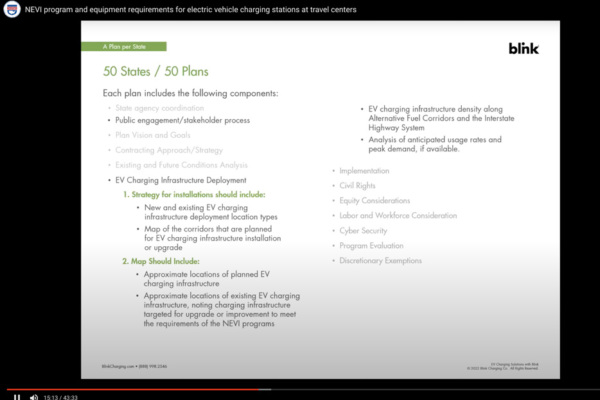On Thursday, October 20, 2022, the NATSO Foundation and NATSO’s Chairman’s Circle Member Blink Charging partnered to offer a webinar on electric vehicle charging station incentives and equipment.
The bipartisan Infrastructure Investment and Jobs Act (IIJA) included $7.5 billion in grants under a National Electric Vehicle Infrastructure program, marking the first time that dedicated electric vehicle charging funds were made available in an infrastructure bill and creating new opportunities for truckstops and travel plaza operators to help build out the nation’s charging network.
Attended by almost 250 listeners, the webinar is another tool created by the NATSO Foundation to help truckstops and travel centers gather the information and analysis they need to take advantage of the national and local incentives available for electric vehicle charging stations, CNG, propane and/or hydrogen.
Reach out the Blink team with questions at NEVI@blinkcharging.com.
Key Takeaways
NEVI Program Overview. “These grants will be awarded to state departments of transportation over five years to implement EV charging along designated alternative fuel corridors,” said Tiffany Walzlowski Neuman, NATSO’s vice president, public policy, while speaking during the NATSO webinar. “NATSO worked very hard leading up to passage to IIJA to ensure that our industry was suited to take advantage of these grant opportunities.”
Walzlowski Neuman said there are three critical elements in the IIJA that allow truckstops and travel plazas to compete in the EV charging space. First, congress determined that state DOTs must partner with the private sector to implement their NEVI funds. Locations for alternative fueling must also consider secondary amenities such as restrooms and food offerings. Plus, the administration issued guidance that states can't implement charging at rest areas and must comply with the federal ban on fuel sales at rest areas.
“All three of those items were very important to make sure fuel retailers can invest in EV charging,” Walzlowski Neuman said, adding that since the law passed, NATSO has encouraged members in every state to engage with state DOTs and educate them on what a successful partnership may look like.
STATUS of NEVI Program State Proposals. Each state is independently determining its National Electric Vehicle Infrastructure (NEVI) plan and working closely with the Department of Transportation, explained Amber Muse, Blink Charging’s director of site acquisition, government grants, who also took part in the webinar. The federal NEVI program requires that fast charging is installed on alternative fuel corridors every 50 miles and within one mile of the interstate. However, it does make some exceptions in the west if electric power is not readily available within one mile of the interstate.
The Biden Administration has signed off on proposals for all 50 state DOTs. State DOTs are currently holding meetings to learn how to best partner on locations, preparing more formal RFPs to determine how to partner or issue more comment periods. It is important for NATSO members to continue to participate and respond to RFPs. “Now is not the time to let up on our efforts,” Walzlowski Neuman said.
“Travel centers are the perfect alignment with this initial rollout for the NEVI plan, and this plan was specifically designed for your locations," Muse said.
While the initial first-year rollout is for light-duty electric vehicles, it is expected to grow with heavy-duty transportation. “The bipartisan infrastructure law is truly transformational when it comes to deploying charging infrastructure across the country,” said Matthew Chen, director of government affairs for Blink Charging.
EV Tipping Point. During the webinar, Chen cited Bloomberg news research that shows there is a tipping point at which EV adoption really starts to take off. “They’ve identified that once EV adoption reaches the 5% mark for new sales, the rate of adoption rapidly increases. They projected that if the U.S. follows this trend, a quarter of new cars in the U.S. will be fully electric by 2025,” he said, adding that 19 countries have reached the 5% benchmark.
Additionally, federal policy has acted as a significant accelerant of EV adoption. Chen said the recent Inflation Reduction Act is estimated to increase EV adoption by around 10% through a variety of important credits and rebates. “This is an incredibly exciting time to be part of the EV charging and greater EV industry,” he said, adding that 2022 is an unprecedented year of incentive funding for trucking.
For example, in California for the fiscal year 2021 and 2022, funding for heavy-duty and off-road equipment is just over $873 million, which is nearly equal to the historical cumulative amount of $881 million allocated for heavy-duty and off-road equipment from 2013 to 2020.
California is setting a benchmark many other states are following. In New Jersey, for example, there is a pilot program called New Jersey Zip, which is a voucher incentive program that operates much like those in California and New York. In Feb. 2021, Massachusetts extended its own rebate program for electric vehicles, including vouchers for medium and heavy-duty battery electric vehicles and fuel-cell trucks.
Additionally, a series of grant programs will likely be announced by the end of the year and will provide a combination of charging both at corridor locations and communities throughout the country.
Subscribe to Updates
NATSO provides a breadth of information created to strengthen travel plazas’ ability to meet the needs of the travelling public in an age of disruption. This includes knowledge filled blog posts, articles and publications. If you would like to receive a digest of blog post and articles directly in your inbox, please provide your name, email and the frequency of the updates you want to receive the email digest.

